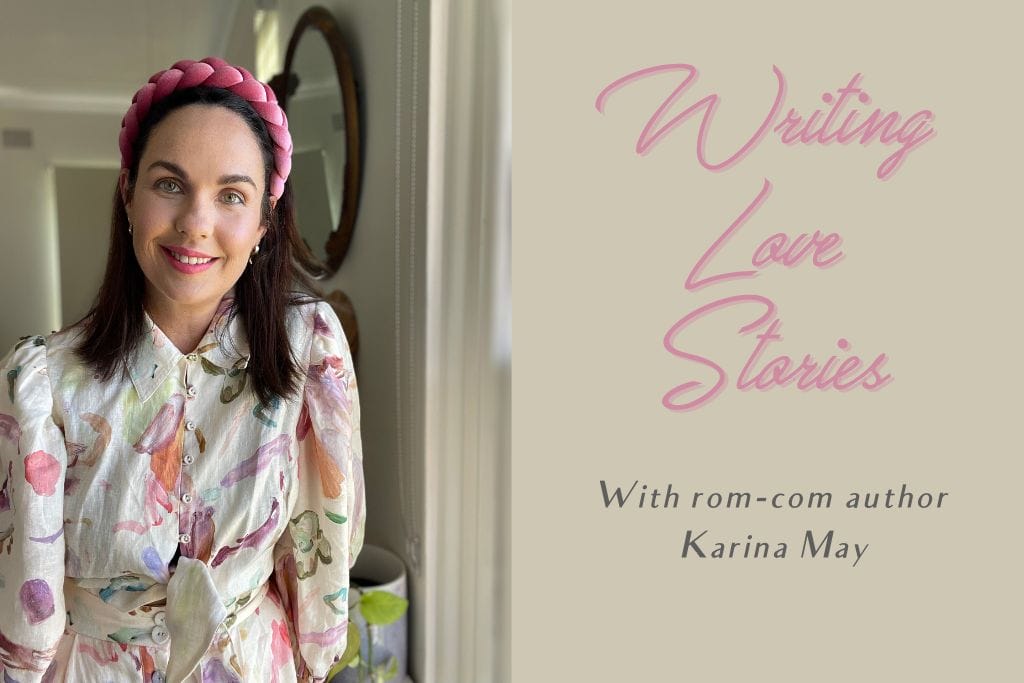Celebrants chat with Australian rom-com author & podcaster Karina May
Karina May is an expert in love stories. As the author of Duck a l’Orange for Breakfast and Never Ever Forever and the co-host of That Rom Com Pod (along with fellow author Clare Fletcher), Karina eats, sleeps and breathes romance.
While writing a novel is quite a different experience to crafting a marriage ceremony, when talking about love, some ideas are universal.
Last week, we were lucky to have join Karina The Celebrant Society via Zoom to chat with NSW Local Leader Alison Pickel. She shared her insights on engaging audiences, her writing process and why story tropes can be useful.
Here are a few key takeaways from her TCS chat:
Give yourself space to “procrasticreate”
Begin with a title
It’s a radical idea in the publishing world, but the first thing Karina writes in her novels is the title. It could be thematic or it be based on the plot, but the title helps her create structure and gives a consistent throughline in her stories.
Giving a name to our couple’s stories might seem a little unusual, but it also might just be the genius hack you need to find the direction of your writing.
Start on the day that is different
Even before writing books, Karina has always been a storyteller. She noticed that when recounting events to friends, she would often start in the middle. It was only when she became a writer that she realised why she was doing that: it’s usually the most interesting part of the story.
The inciting incident, or what Karina calls “the day that is different”, is likely the most engaging hook for audiences. In a love story, this might be the “meet-cute” (the moment when the two protagonists encounter each other and sparks fly), or it could be the proposal. Instead of being chained to chronological events, find the moment that is special and unique in their relationship and start there.
Once you’ve identified that incident, dig into the details to bring it to life. Karina believes it’s far more interesting to delve deeper into those moments than to attempt to cover the whole relationship.
Bake the cake
A funny piece of dialogue or a quirky scene is all well and good, but it can feel like a cheap thrill if there is no purpose behind it. That’s why Karina likens her writing process to cake making.
She starts with ‘baking the cake’: figuring out what needs to be communicated to get from point to point. Once those foundations have been laid, she can start ‘icing the cake’ i.e. adding those flourishes which bring colour to the story.
Use tropes as shorthand for audiences
Tropes are big in the romance world: enemies to lovers; forced proximity; second-chance romance; workplace romance etc.
Tropes can be especially helpful in telling short stories because you don’t have to waste words explaining it to audiences. They already know what to expect and that creates a level of comfort for them.
Identifying a trope that exists between real-life couples can help you find the story beats to create a cohesive template.
Karina gives the example of the friends-to-lovers trope:
- Beat 1: the hook / the meet-cute / the inciting incident
- Beat 2: the mid-point – the tension of will they/won’t they or an obstacle to raise the stakes
- Beat 3: the tipping point – getting together
- Beat 4: the highest point – this is how deeply they can love
Find what works for you
If you’d like to learn more about Karina May, read her books or listen to her podcast, visit: karinamay.me
To learn more about how to write incredible love stories, sign up for Ben Ager’s Online Creative Writing Masterclass. TCS Members get a $100 discount!




